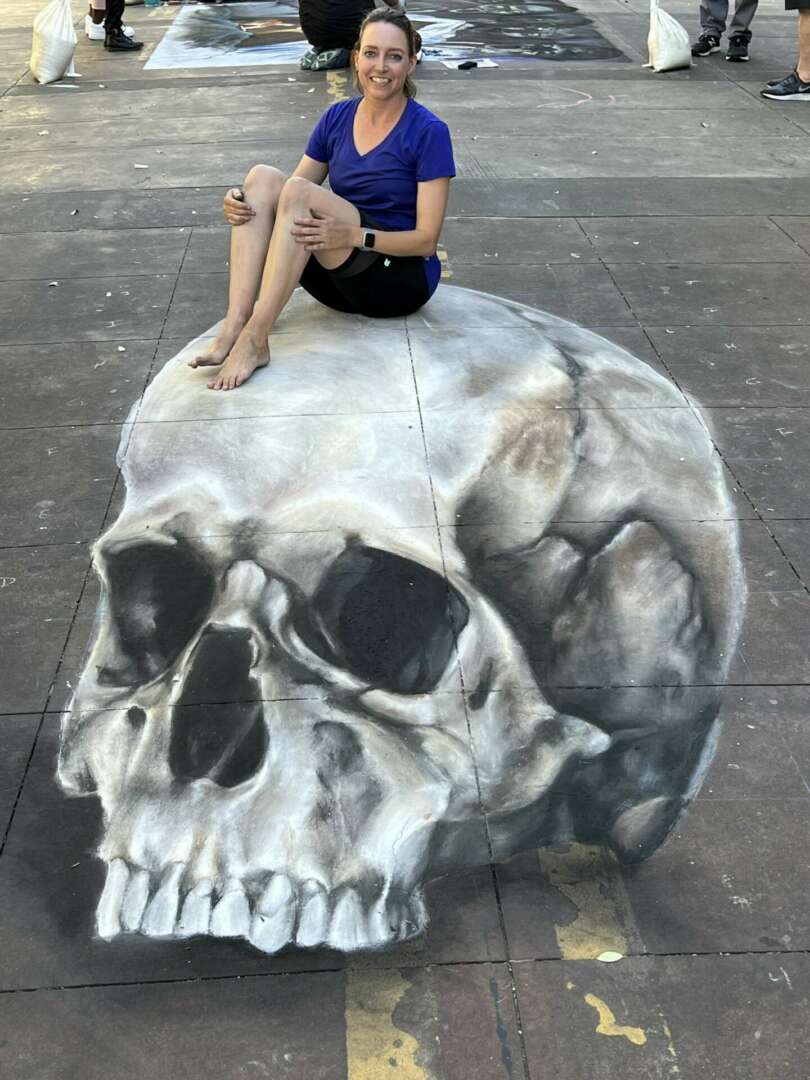We caught up with the brilliant and insightful Jan Riggins a few weeks ago and have shared our conversation below.
Jan, thanks for taking the time to share your stories with us today Learning the craft is often a unique journey from every creative – we’d love to hear about your journey and if knowing what you know now, you would have done anything differently to speed up the learning process.
I kind of stumbled into chalk art. As a hobby artist most of my life, I periodically picked up colored pencils and spent years at a time working on one piece (simply because I never dedicated much time).
7 years ago, my local town started a chalk art festival. There was a professional division with a handful of professional chalk artists, and the amateur division for anyone to participate in for free. I signed up for the amateur division and was in awe of the professional artists. The second year of the festival, I won the amateur division and was invited back after that in the professional division.
At this point I had chalked two times in my life. This continued for several years with the addition of two other local festivals. In 2020, when COVID hit, I had only chalked a handful of times and I was very disappointed when festivals were being cancelled. Out of frustration, I started chalking on my sidewalk. During those first months of COVID, everyone was staying home and spending a lot of time outdoors. My neighbors gave me a lot of positive reinforcement, especially when my then 13 year old daughter started joining me. We then started taking requests from neighbors and chalking on other driveways for special occasions. I started to figure out that we could make our work look very realistic if we used appropriate shading and shadows. We then had many people say that we were doing 3D chalk art, but I knew we weren’t. I had seen the professional artists at festivals doing 3D art and it involves using an anamorphic grid.
I decided I wanted to learn how to do this, but, there were no festivals happening for me to learn from others…and there really aren’t tutorials online on how to do anamorphic chalk art. Through watching a couple of older YouTube videos, I learned how anamorphic art worked, but I didn’t have the computer skills to manipulate reference photos. I then spent close to a year trying to figure out Photoshop on my own until I started asking other artists for help. I have a friend that is an amazing watercolor artist in California with strong Photoshop skills. She spent hours on Zoom with me showing me what I needed to know to create my anamorphic reference photos.
Now I was creating true 3D art! I kept practicing like crazy in my driveway and I was now starting to get hired out fairly regularly for chalk art jobs. And then…chalk art festivals started happening again and I started getting invited to some of the large festivals! Spending time around other artists is when I really started gaining traction. There is nothing better than learning from others and lots and lots of practice!



Great, appreciate you sharing that with us. Before we ask you to share more of your insights, can you take a moment to introduce yourself and how you got to where you are today to our readers
Over the past couple of years I have joined the fairly niche field of 3D Chalk art. I provide temporary installation art pieces that provide an interactive element with the public. Chalk art is often used as performance art, allowing the public to observe the process and interact with the artist and the piece. I have worked with business to provide this service for company events, advertising, and to simply boost morale. I love creating pieces that make people chuckle or smile when they see it…and then try to figure out how it was made.
What do you think is the goal or mission that drives your creative journey?
I feel like I floundered quite a bit when I started focusing on art. I didn’t feel like I had a clear path to take. I was working a full time job (and still do), but knew I wanted to take the next step and focus more on art. For a long time, I looked to the artists I saw being successful and tried to follow their paths. But I later realized, that only leads to disappointment. Out of frustration, I decided to only do what I wanted to do. No more commissioned paintings and no more painting what I thought others wanted to buy. I decided if I wanted to keep finding joy in art, I would need to start saying “no” to things that I didn’t love.
After focusing on my art like this for a couple of years, I started focusing more on chalk art. Then I spent a year saying “yes” to everything. I decided I wanted to see what happened when I stopped saying no and started taking on projects that might not interest me…just to see where they led. And at this point I realized how important it is to make connections. These connections often started leading down some very interesting paths.



For you, what’s the most rewarding aspect of being a creative?
For me, I receive immense satisfaction from knowing that I can create something temporary and beautiful out of a few sticks of pastels. Because I know most of my artwork is temporary, I try to simply enjoy the process. There is simply NOTHING that feels better than the process of creating art and seeing how others react to it.
Contact Info:
- Website: www.janrigginsart.com
- Instagram: @janrigginsart
- Facebook: @janrigginsart
- Other: TikTok – @janrigginsart


